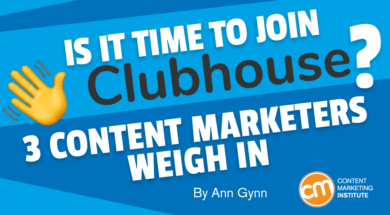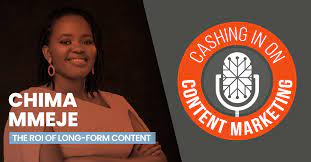 Phenomenal doesn’t begin to describe Clubhouse’s growth in its first year. The drop-in audio app grew from 1,500 members in May 2020 to 10 million in February 2021.
Phenomenal doesn’t begin to describe Clubhouse’s growth in its first year. The drop-in audio app grew from 1,500 members in May 2020 to 10 million in February 2021.
With numbers like that, it only makes sense for content marketers to be interested in Clubhouse’s potential. But is Clubhouse the right place for your brand to gather? And if so, how?
I’ll give you a peek inside the “exclusive” Clubhouse through the experiences of three people in content marketing who use it.
What is Clubhouse?
Clubhouse is an audio social networking app. It’s only available for iOS, so only iPhone users can join. (Expansion to include Android could be coming later this year.)
Part of the app’s attraction (and the nuisance) is that people must be invited to join. Each new Clubhouse member gets five invitations to send. The “nominator” is identified below the member’s profile.
Once admitted, members can search for people to follow, clubs to join or follow, and chat rooms to join. Topics include everything from starting a business to bitcoin investment to reality TV to sports and more.
Any member can join an existing room or start a new room. In each room, there are two categories of people –listeners and speakers. Everybody in the room can see a list of who is on stage and who is listening. If the speakers opt to take questions or interact, listeners can tap the hand icon. The moderator then can bring that person to the “stage” to speak.
The first speaker in the room is the moderator by default. Moderators have the power to let speakers on stage as well as to kick out members who violate the code of conduct.
To be eligible to create a club, members must have started a chat room at least three times. Clubhouse administrators must review and approve your club request.
As an audio-only app, Clubhouse is inaccessible to people who have hearing difficulties. And there’s no integrated feature for recording any of the room conversations.
So what’s the opportunity for brands? To find out, I talked with three marketers about their experiences on the platform.
Is there a place for #ContentMarketing on #Clubhouse? @PedigreeUS, @chimammeje, and @MfgHappyHour share their experiences and advice via @AnnGynn @CMIContent. #SocialMedia Click To TweetPartnering help brands stay out of the doghouse
Pet-food brand Pedigree took to the Clubhouse stage this spring. “We know that dogs are some of the best listeners, so right off the bat, it seemed like a natural fit,” says Craig Neely, vice president of marketing at Mars Petcare.
That’s a nice thought, but Pedigree’s commitment to Clubhouse was strategic. It used the platform to further the mission of finding forever homes for dogs in need.
We all know that Dogs bring out the good in us. Join PEDIGREE for our first Q&A on Clubhouse as we talk with Shelters about how we can bring out the good in them. Featuring furry special guests on 3.24 @ 5:30PM est. https://t.co/oHV4BM8zd1 #Doghouse pic.twitter.com/t02Psh4isd
— Pedigree (@PedigreeUS) March 23, 2021
“We knew that the people on Clubhouse were talking about topics where we believe dogs can make a real difference, like mental and physical health, making it a relevant space to raise awareness of dog adoption,” Craig says.
Pedigree partnered with three moderators who already led Clubhouse chats about mental and physical health: Nidhi Tewari, host of the Mental Health Matters club; Alessandra Torresani, host of the Emotional Support club; and Jamaica Aali, host of The Monday Motivation Club.
Craig says the moderators also share the brand’s belief in “the benefits of pets and importance of pet adoption.”
Each host opened their room chat at a scheduled time to talk about the benefits of dog ownership as it related to their topics. They introduced four adoptable dogs from Pedigree shelter partners who “joined” the conversation.
Since a bark probably wasn’t enough to say “adopt me,” each participating shelter published a profile of the dog – photo, description, and link to its adoption page – on their website. Room hosts shared links to those sites.
The event culminated with a Pedigree room chat on the importance and benefits of adoption hosted by Alessandra of the Emotional Support club. Representatives from the partner shelters also joined the conversation.
All four dogs got adopted.
While the Clubhouse event was a first, it wasn’t the first time Pedigree has taken pet adoption promotion to virtual platforms. In the early months of the pandemic, it hosted Dogs on Zoom, virtual adoption events with shelters around the country.
“This ‘Doghouse’ activation is a continuation of that innovation in finding new ways to promote dog adoption, especially in a virtual space,” Craig says. “Clubhouse seemed like such a great opportunity for us to play in a new space while also getting adoptable dogs in front of people in a unique way.”
By partnering with existing clubs that were already talking about destressing, overcoming anxiety, and being more active – things pet ownership can have a positive impact on – Pedigree didn’t have to build its own audience.
Craig does offer this caveat for brands: “People are on Clubhouse to be a part of meaningful conversations,” he says, “so it’s important to make sure that any sort of branded integration feels authentic to those discussions and doesn’t take away from the experience that people are looking to get out of it.”
Takeaways:
- Find partners. Ask influencers, moderators, and club hosts to join you or if you can be invited to speak in their rooms. Influencers, popular club hosts, etc., not only bring credibility to the conversation, but you gain access to their Clubhouse following and widen your audience.
- Be authentic. Your Clubhouse conversation needs to be authentic to your brand and to the room.
Offer access to people (not brands)
Chima Mmeje, a freelance content writer and strategist for SAAS and tech companies, is a listener, participant, and host on Clubhouse. “It’s a real gold mine for those who get in fast,” she says.
She broadcasts her podcast on Clubhouse while simultaneously recording it for YouTube. Recently, she was a guest on Fractl’s Cashing In on Content Marketing podcast, which was hosted simultaneously on Clubhouse and recorded via Zoom.

But is Clubhouse a bonanza for companies? Only if they do it right.
“Nobody wants to listen to a brand on Clubhouse,” Chima says. “They want to listen to decision-makers who’ve figured it out,” she says. “Clubhouse is great because it gives direct access to these influencers [so the audience] can ask questions and receive real-time feedback in a way that’s impossible with traditional audio or video podcasts.”
Nobody wants to listen to a brand on #Clubhouse. They want to listen to decision-makers who’ve figured it out, says @chimammeje via @AnnGynn @CMIContent. #SocialMedia Click To TweetTakeaways:
- Identify leaders and subject matter experts who would be good on the Clubhouse stage. They should be good at public speaking and at interacting with an audience they’re not familiar with.
- Use a third-party tool to record your Clubhouse room conversations. You can use the recordings to extend the life of the conversation to other platforms. Just be sure to make clear to the room that they are being recorded.
Make sure the conversation goes both ways
In pre-pandemic times, Chris Luecke recorded his podcast in person over a pint (or other beverage of choice) with makers, founders, or other leaders in the manufacturing industry. They talked tools, tactics, and strategies to take manufacturing careers and business to the next level.
Now, Chris records those conversations virtually. But he’s also expanded the podcast, creating weekly fireside chats on Clubhouse, like this one with Factory Fix Founder Patrick O’Rahilly.
The differentiator between his podcast and Clubhouse rooms? It’s a two-way dialogue. Originally, Chris used Zoom to host all his fireside chats, but he finds Clubhouse has advantages. It’s informal, and by creating a club – Manufacturing Happy Hour – he gets to have an ongoing connection to his followers.
He’s bullish on Clubhouse opportunities for marketers. The key is to focus on your niche and stay away from generic, broad sessions that tackle the same topics as a lot of other clubs and rooms.
“Clubhouse’s staying power is the niche conversations,” Chris says. “They are great opportunities for discussion …. That’s where it has some power – get into the details.”
Clubhouse’s staying power is the niche conversations, says @CWLuecke of @MfgHappyHour, via @AnnGynn @CMIContent. #SocialMedia Click To TweetChris also considers Clubhouse a great solution for the biggest challenge faced by most live-turned-virtual events – networking. Last month, Chris hosted a networking event for the Automate Forward conference:

The Clubhouse event was listed on the show’s agenda. Conference attendees could join the platform and find the happy hour by searching for the conference name – Automate Forward – or through the Manufacturing Happy Hour club.
“Everyone doesn’t enter the conversation all at once; it’s like a real in-person networking event,” Chris says. “If Clubhouse becomes the mainstream platform – more accessible – I think it could be the answer to everyone’s collective struggle on how to do a good networking event.”
Takeaways:
- Go niche, not broad. By creating more narrowly focused rooms and clubs, you can cultivate unique conversations and grow a specialized community.
- Use Clubhouse for networking events. It can be easier for virtual conference attendees to join a platform they’re familiar with rather than trying to navigate cumbersome platforms within online events.
Sound familiar?
The Clubhouse advice should sound similar to more general content marketing counsel:
- Distribute content where your audience is.
- Interact authentically. The messenger, message, and behavior should fit both your brand and the platform.
- Focus on your niche or specialty topics to appeal better to your target audience.
- Expand your reach by partnering with others who give you access to their audiences.
- Get the most from your content by repackaging it for other distribution platforms.
- Interact with and respond to your audience.
Finally, even if you don’t think Clubhouse’s exclusivity fits your content marketing strategy, you still should be thinking about audio content. Twitter, Facebook, LinkedIn, and others are all working on the audio chat game.
How are you seeing brands or individuals using Clubhouse as a content marketing tool? Please add in the comments.
Cover image by Joseph Kalinowski/Content Marketing Institute

